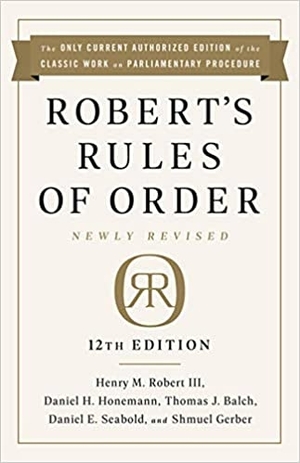Small board rules are different
Updated July 14, 2021
 The different rules for small boards are one of the best-kept secrets of Robert’s Rules of Order. If you serve on a small board (up to about 12 people) you may benefit from the flexibility that the rules for small boards offer.
The different rules for small boards are one of the best-kept secrets of Robert’s Rules of Order. If you serve on a small board (up to about 12 people) you may benefit from the flexibility that the rules for small boards offer.
Robert’s Rules of Order Newly Revised, 12th edition says on page 464, “some of the formality that is necessary in a large assembly would hinder business” in a small board.
The book goes on to list seven significant bullet points about the ways that the rules for small boards are different.
Jurassic Parliament agrees with some of these rules, but not all of them. Read our thoughts on this below.
If your bylaws say that “meetings shall be run according to Robert’s Rules of Order Newly Revised, latest edition,” and your board has 12 or fewer members, you are fully entitled to use Robert’s special rules for small boards.
If you have a slightly larger board, up to about 20 people, you may also find the small board rules useful. In that case, you must adopt the rules you wish to use, which is easy to do. To learn how, see our post on “What are special rules of order?
The different rules for small boards from Robert’s Rules of Order Newly Revised, 12th edition, section 49:21
- Members are required to obtain the floor before making motions or speaking, which they can do while seated. YES, we think this is a good idea, and of course many boards today remain seated during their discussion.
- Motions need not be seconded. NO, we prefer that a second be required for any motion. Before a proposal takes up a group’s time, there should be at least two people who want to talk about it.
- There is no limit to the number of times a member can speak to a question, and motions to close or limit debate generally should not be entertained. YES, provided that the rule that everyone has a chance to speak once before anyone may speak twice is strictly enforced.
- Informal discussion of a subject is permitted while no motion is pending. YES, though it’s useful to ask for a motion just as soon as the chair senses that the group is ready to formulate one.
- Sometimes, when a proposal is perfectly clear to all present, a vote can be taken without a motion’s having been introduced. Unless agreed to by unanimous consent, however, all proposed actions of a board must be approved by vote under the same rules as in other assemblies, except that a vote can be taken initially by a show of hands, which is often a better method in such meetings. YES, provided that someone, eventually, states in clear terms what is about to be voted on.
- The chairman need not rise while putting questions to the vote. YES.
- The chairman can speak in discussion without rising or leaving the chair; and, subject to rule or custom within the particular board (which should be uniformly followed regardless of how many members are present), he usually can make motions and usually votes on all questions. YES, as far as discussion goes. We suggest that boards adopt a rule that the chair debates after others have spoken and votes last. This allows her to summarize discussion to remain more impartial. NO for making motions. We believe it is always better for the chair not to propose motions, because of the human tendency to show undue deference to the leader of a group.



When no one seconded a motion, our board president addressed me by name and asked for a second. I gave it, but complained privately afterward and tried to explain why his request was inappropriate. I’m not sure he understands why, or that he knows to move on if a motion is intentionally not seconded.
Thank you for writing about this incident. It is challenging when chairs don’t understand their role.
Jurassic Parliament promotes the idea that members should feel free to decline a request when it is inappropriate, saying, for example, “I would prefer not to second the motion.” The ordinary social pressure that we feel to go along is a different thing from the methods of parliamentary procedure.
I have been thinking that a blog entry on what “second” means is a good idea, and your message confirms me in that!
Best wishes – Ann
I would really appreciate a post on what “second” means, Ann! I explained to my chair that in a group our size (typically about a dozen people, with a couple more on the phone), a motion can go forward to a vote on its on, without a second. My chair thinks it’s important to have someone second every motion so that can be reflected in the minutes. It’s as though he thinks a motion by itself is not a valid one.